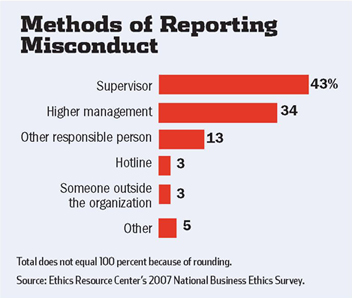 Tales of accounting fraud, racial discrimination and sexual harassment make headlines, but it’s the run-of-the-mill stuff that tends to bug people at work: “I work too many weekends.” “My manager lets Bob off the hook while I slave away.” “We don’t get enough vacation days.” “The cafeteria food stinks.”
Tales of accounting fraud, racial discrimination and sexual harassment make headlines, but it’s the run-of-the-mill stuff that tends to bug people at work: “I work too many weekends.” “My manager lets Bob off the hook while I slave away.” “We don’t get enough vacation days.” “The cafeteria food stinks.”
Managers have heard it all before, but how many of them respond to a complaining employee by saying, “Thanks for telling me about that”? The alternatives -- an empty promise of help or, worse, retaliation -- seem to be more common. No wonder many disgruntled employees don’t speak up.
No one likes to hear complaints, but soliciting them effectively remains critical to an employer’s relationship with employees, ethics and employee relations experts say. A well-run employee feedback program builds trust and loyalty and helps senior managers keep an ear to the ground.
“Unless management has a system by which employees can make them aware of problems, they won’t know problems exist,” says Patricia J. Harned, president of the Ethics Resource Center, an Arlington, Va.-based nonprofit that promotes ethics in private and public organizations.
Because human resource managers often choose, implement and run complaint-gathering programs, such as hotlines and employee surveys, they are in a position to use such programs to identify trouble spots and trends that could lead to organizational changes.

Beyond Compliance
The number of employers providing telephone hotlines to employees has increased since passage of the Sarbanes-Oxley Act of 2002, which requires publicly traded companies to have a confidential, anonymous mechanism for employees to report suspect accounting matters. But, convincing employees to view hotlines and other employee feedback programs as more than a compliance tool is still an “uphill battle,” says Peter W. Lilienthal, president of Minneapolis-based In Touch, a provider of employee feedback programs. Lilienthal considers such programs to be integral to an employer’s broad communication efforts aimed at generating positive and negative feedback.
Timely, candid information has value for purposes “from avoiding lawsuits to getting great ideas for improving the company,” Lilienthal says.
Companies that intentionally create a “culture of candor” foster an environment where employees trust employers enough to voice complaints, says Steve Priest, president of Ethical Leadership Group, a Chicago-based consulting firm.
Without such a culture, open-door policies and hotlines provide little more than lip service, he argues. “If you’ve got a culture where the first to surface gets the harpoon, are you going to hear concerns?” Priest asks. “No.”
HR directors can help overcome this reluctance to complain by making available reporting mechanisms that ensure anonymity and confidentiality and by regularly reviewing feedback programs to make them as barrier free as possible.
Hearing Them Out
Employers can solicit employee concerns and complaints by various means, including:
- Training supervisors to listen and respond to workers.
- Implementing telephone and web-based hotlines.
- Conducting employee satisfaction surveys.
- Hosting employee focus groups.
- Making available ombudsmen and suggestion boxes.
HR managers and consultants generally prefer that employees raise concerns internally by talking to their managers or other trusted individuals because it indicates an organizational level of trust. In fact, that’s what most workers do, according to the National Business Ethics Survey, conducted biennially by the Ethics Resource Center.
The 2007 edition of the survey found that among employees who recently reported misconduct, 43 percent went to their supervisors, 34 percent went to higher-level managers, and 13 percent went to others such as HR managers, ethics officers or ombudsmen. Only 3 percent used hotlines.
“Employees prefer to go to someone they know more than established channels like a hotline. If HR is an employee advocate, there is a good chance an employee would go to them,” Harned says.
Eric M. Heath, SPHR, vice president of human resources at the Peabody, Mass.-based East Boston Savings Bank, relies on informal feedback to gather gripes from the bank’s 230 employees.
Training line managers to listen to complaints has become central to his “no-fault feedback” approach. Managers should “ask some probing, open-ended questions” to get to the bottom of the problem, he advises. Then they should thank employees for raising the issue and respond respectfully. “You’ve got to honor the complaint,” he says.
Also, Heath recommends that in some cases managers explain to employees “why things are the way they are,” and, if the manager can’t help, he or she should refer the employee to someone who can.
Heath says the bank also has conducted employee satisfaction surveys and hosts an open-to-all breakfast every six weeks with the company president called “breakfast with Bob.”
East Boston Savings Bank is relatively small, so Heath and his four-person staff accept many complaints personally and train managers on how to deal with them. For larger national and global organizations, employee hotlines grant accessibility and an outlet for people who aren’t comfortable reporting a problem to a supervisor.
Ron Myers, senior HR manager at Cabela’s, a 14,000- person outdoor outfitter based in Sidney, Neb., with more than 40 U.S. locations, says hotlines “measure the climate of your workforce.” Cabela’s hotline vendor responds to calls within 48 hours of notification, at least to touch base with the caller. Myers says the system “has been invaluable to us to know what’s going on in the field.”
Hotlines allow employees to report complaints anonymously and confidentially through a neutral third party. Workers can call a toll-free number, available around the clock, and talk to a trained interviewer, who routes a written summary to the employer. Callers get a case number so they can check on the status of a complaint later.
Not everyone wants to talk to a live operator, though, so many hotlines allow users to call and leave a message or to submit an e-mail through a vendor’s web site or a company intranet. The service typically costs
50 cents to $1.50 per employee annually for a strictly ethics-related hotline and $2 to $3 for one that accepts any kind of complaint, Lilienthal says. Most vendors charge yearly minimums.
The downside of hotlines: Despite assurances of confidentiality, some employees still fear being identified through a traced call or e-mail. But the right publicity -- through posters, newsletters, employee orientations and the employee handbook -- can help.
“We call it the ‘power line.’ We hope employees feel empowered by using it,” says Paul M. Melihercek, senior director of employee relations at DHL Express, an overnight delivery company with 20,000 employees and more than 13,000 independent contractors in the United States.
With 475 locations -- some without an HR professional on-site -- and many employees on the road, DHL uses several approaches to keep tabs on employee concerns, Melihercek says. For instance, the company trains its front-line supervisors to resolve complaints, and it conducts employee opinion surveys. Certain issues, such as seniority, go through a Teamsters contract’s grievance-resolution procedures. DHL’s three-year-old power line has received complaints on everything from dirty bathrooms to business fraud.
“We want to have a culture where people are encouraged to resolve things locally,” says Melihercek, before considering a third-party intervention by a lawyer or government agency. In recent years, DHL has seen fewer such outside interventions, he says.
Offering different reporting channels suits different employees’ comfort levels, experts say. “You want to have different channels for different personalities,” says Ruth V. Aguilera, associate professor of business at the University of Illinois at Urbana-Champaign. Employees who are introverts, for example, may feel more comfortable with an employee hotline than a focus group.
Is It Working?
The percentage of employees who use hotlines serves as one rough measure of the reporting option’s success. Compliance-oriented hotlines that solicit reports of fraud and other potential crimes have a utilization rate of 0.5 percent to 2 percent, compared with 5 percent to 10 percent for broader employee hotlines, In Touch says. But is no news good news? Not necessarily. Few calls could mean that employees are happy -- or that they don’t know about or don’t trust the company’s reporting service.
To probe deeper, vendors and HR managers analyze the number, location and type of calls to identify trends and risks. At Cabela’s, Myers says he uses his hotline provider’s quarterly reports and results of annual employee engagement surveys to find location-specific sore spots and to identify other issues that need to be addressed. For example, many calls from one store may reveal a weak manager who needs more training. HR staff follow up by visiting the site and talking to employees.
Myers also reports hotline results, complaints and responses every month to Cabela’s chief executive officer and vice president of HR “to make sure these concerns are being elevated.” Managers of each business unit get their own custom reports.
Employers that internally audit their hotlines to monitor call-handling, response time and reporting quality can use that information to examine their complaint process and eliminate barriers to use. For example, some hotline methods are not ideal for overseas and non-English-speaking employees.
Whistle-blowing is an unfamiliar concept in some cultures, so employees should be trained to understand a hotline’s purpose, Aguilera says. The translation process matters too. Translation during a live call is time-consuming and not always reliable, Lilienthal says. A better yet costlier method is to have the call answered automatically in the caller’s language, then have the caller’s message transcribed, translated into English and sent to HR.
Before engine maker Cummins Inc. switched to this type of hotline, many callers hung up before talking with an interviewer, says Sondra Bolte, HR director of global ethics investigations. A new vendor and more publicity boosted the percentage of calls received from overseas by the Columbus, Ind.-based company with 38,000 employees to 30 percent, up from 2 percent two years ago. “There was a push to make sure employees outside the United States were aware of [the hotline],” Bolte says.
Finally, keep employees informed. Employees should be told of actions resulting from their reports. Produce periodic general summaries, including all follow-up actions, without naming names, suggests the Ethics Resource Center’s Harned.
Ultimately, it’s up to HR to decide what employee complaint methods work best, given an employer’s size, workforce and geography. For better feedback, make sure complaints don’t fall on deaf ears and that real action follows promises of help.
An organization run by AI is not a futuristic concept. Such technology is already a part of many workplaces and will continue to shape the labor market and HR. Here's how employers and employees can successfully manage generative AI and other AI-powered systems.



